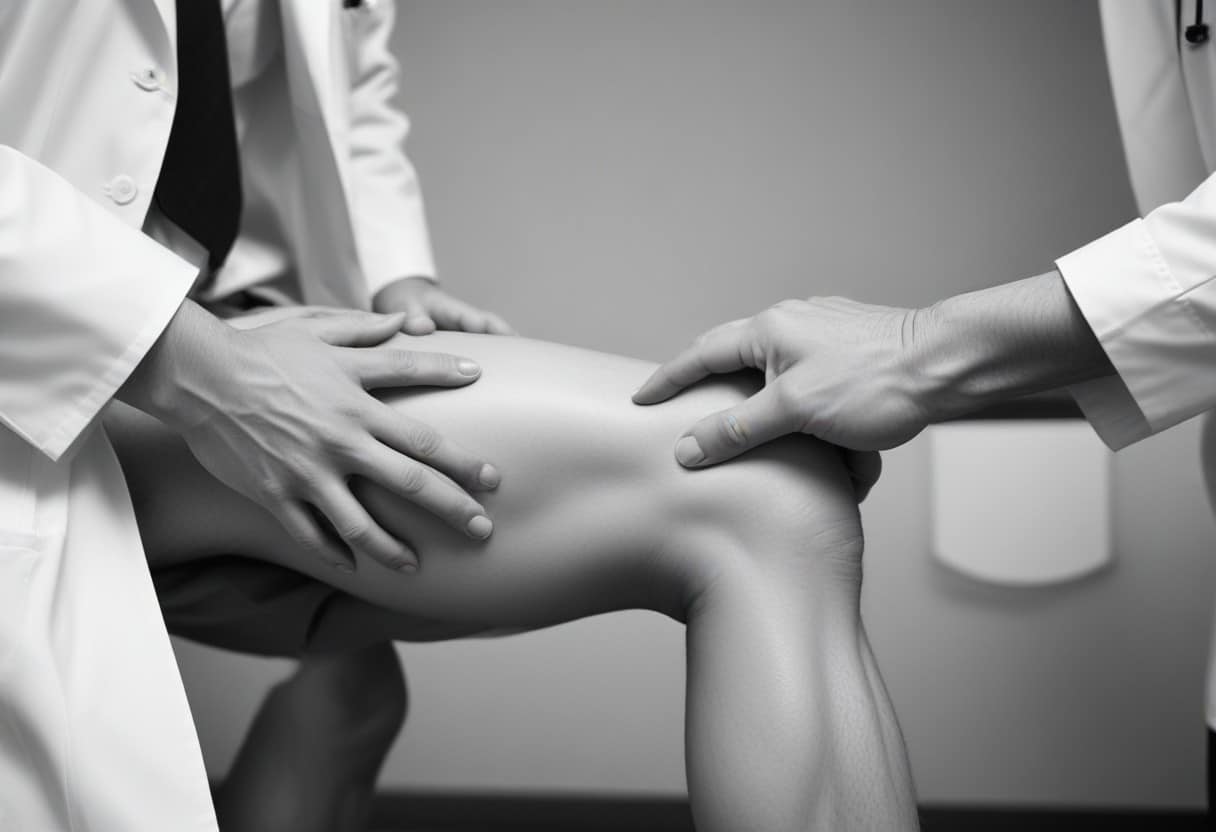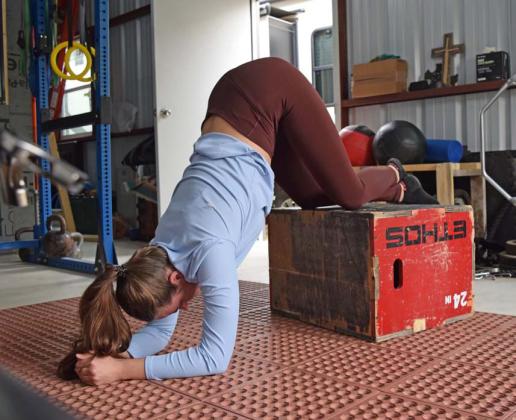Are you searching for an answer to the question, “Does sciatica cause knee pain?” Millions of people worldwide suffer from conditions like Sciatica and knee pain. Sciatica is caused by putting pressure on or irritating the sciatic nerve. It causes shooting pain, stiffness, or tingling in the lower back, buttocks, and one leg. Knee pain, on the other hand, can be caused by several things, such as an accident, arthritis, or too much use. Even though these conditions seem separate, more and more people are interested in how they might be linked.
Many people who have Sciatica also say they have knee pain, which makes me wonder if Sciatica can directly cause knee pain or if there’s some link between the two. You must understand this link to create a good diagnosis and treatment plan. If Sciatica can cause knee pain, it could be a sign of a bigger problem affecting more than one part of the body.
Knee pain caused by Sciatica could result from compensatory moves or different walking patterns due to lower back and leg pain. In this article, we delve into the question: Does Sciatica cause knee pain? We’ll discuss possible causes, typical symptoms, and ways to deal with this double problem, which will help people with both conditions.
Understanding Sciatica and Knee Pain
The Sciatic nerve is the longest nerve in the body and causes pain in the lower back, buttocks, and leg. It can be constricted or aggravated by herniated discs, spinal stenosis, or muscle spasms. Understanding the question, “Does Sciatica cause knee pain?” illuminates how Sciatica affects adjacent areas like the knee and offers complete treatment strategies.
Injury and arthritis can cause knee discomfort. Sciatica and knee pain correlate despite their apparent differences. Sciatica may cause knee discomfort indirectly. Sciatic nerve irritation or compression can change biomechanics and movement patterns.
Compensations include favoring one leg or changing gait, which can strain the knees and surrounding structures. Anatomy may cause Sciatica and knee discomfort. Sciatic nerve compression can compromise knee alignment and stability due to lumbar spine or pelvic disorders. Rapid imbalances or dysfunctions in these places can cause pain and suffering throughout the body.
Bending forward or lifting heavy objects might worsen knee discomfort for Sciatica sufferers. Due to the interdependence of musculoskeletal health, the complete kinetic chain is used to evaluate and treat Sciatica and knee pain.

Does Sciatica Cause Knee Pain?
Doctors and patients are curious about Sciatica knee pain. Although Sciatica mainly affects the lower back and legs, its effects on the knee are gaining attention. Referred pain possibly links Sciatica to knee discomfort. When compressed or inflamed, the sciatic nerve can send pain signals to the knee and other places. When nerve signals from one body region are received in another as pain, it is called referred pain. Therefore, Sciatica-related lower back or buttock pain may cause knee pain.
Researchers and clinicians have illuminated this association. People with Sciatica commonly suffer knee discomfort, suggesting a link. Medical professionals often find nerve compression or dysfunction in the lower back and knees. Sciatica and biomechanical reasons may also cause knee pain. Sciatic nerve inflammation can alter moving patterns, compensating mechanisms, and gait, affecting knee alignment and stability. Eventually, this may stress the knees and associated bones, causing pain.

Identifying Symptoms and Patterns
Sciatica is a disease where pain travels along the sciatic nerve. Because of the way its pain signals travel, Sciatica can indeed cause knee pain. When the sciatic nerve is pinched or swollen, it can cause pain that goes down the leg from the lower back, often to the knee and even further. This happens because the sciatic nerve splits into smaller nerves that supply nerves to different muscles and tissues in the leg, such as those around the knee. Because of this, people with Sciatica may have back, legs, and knee pain.
However, having knee pain along with Sciatica can make evaluation and treatment more difficult. Healthcare professionals must carefully look at the patient’s symptoms and medical background to tell the difference between knee pain and pain in the lower back. Patients may only think about their knee pain, making it hard to get a complete picture of their situation. Case studies and real-life examples can help explain how hard it is to diagnose and treat Sciatica and knee pain. For example, a person who comes in with Sciatica and knee pain might only get care for the knee initially without paying attention to the sciatic nerve pain.
Symptoms may stay the same or worsen over time if the cause is not fixed. In clinical practice, the best way to treat Sciatica and knee pain is with a complete method that looks at how symptoms and underlying conditions are linked. This could include a mix of treatments, like physical therapy, medicine, and specific movements, to ease the pressure on the sciatic nerve and fix any knee problems that are happening at the same time. Healthcare professionals can make personalized treatment plans to help people get the best results when they understand the link between Sciatica and knee pain.
Addressing Underlying Causes and Contributing Factors
A lumbar disc herniation or spine stenosis can cause Sciatica, resulting in knee pain. This happens because the sciatic nerve goes a long way and affects feelings down the leg, usually around the knee. However, knee pain can also be caused by muscle imbalances or joint problems that aren’t tied to Sciatica. Methods of diagnosis are essential for finding the exact source of pain. Imaging methods, such as MRI scans, help find structural problems like disc herniation or spinal stenosis, which leads to a more accurate evaluation.
Physical exams and neurological tests can also help determine how healthy nerves work and what muscle changes are causing knee pain. A complete evaluation is necessary for making personalized care plans. This means taking into account the symptoms and the patient’s general health, way of life, and goals. Individualized approaches may include a mix of therapies, such as physical therapy, medication, and sometimes surgery or slightly invasive procedures.
Healthcare professionals can successfully treat Sciatica and knee pain by addressing the underlying causes and factors that worsen the pain. Treatment aims to ease symptoms, make it easier to move around, and improve quality of life. Healthcare workers and patients must work together to use a holistic approach to pain management that leads to the best results and long-lasting relief.
Treatment Strategies and Management Approaches
When treating Sciatica-related knee pain, treatment plans rely on all-around approaches to management:
- Conservative methods: Conservative methods such as physical therapy, stretching exercises, and changes to one’s lifestyle are often the first steps in getting rid of pain. These methods are meant to reduce swelling, strengthen muscles, and increase movement so that Sciatica and knee pain can be treated simultaneously.
- Physical therapy: Correcting muscle imbalances and improving posture are essential parts of physical therapy. This can ease pressure on the sciatic nerve and lessen the stress on the knee joint.
- Targeted stretching: Targeted stretching techniques can also help relieve tension and make moving in the affected areas easier. Changing your lifestyle, like adjusting your workspace and watching your weight, can help you deal with pain even more by easing the stress on your spine and joints.
- Conservative treatments: You may consider advanced methods like epidural steroid shots or surgery when conservative remedies fail. However, these choices are usually only for very bad or persistent cases.
Healthcare professionals can successfully treat Sciatica-related knee pain by using a multidisciplinary approach and making treatment plans specific to each person’s needs. This helps with recovery and improves overall quality of life.
Preventive Measures and Self-Care Tips
Taking preventative steps and making self-care routines a part of daily life can help prevent Sciatica-related knee pain and reduce the chance it will return. Keeping your spine healthy is very important, which shows how important good posture and ergonomic habits are.
When you’re properly aligned, you put less stress on your spine and lower your risk of Sciatica nerve compression, which makes knee pain from Sciatica less severe. Adjustable chairs or cushions to support the lower back can make a big difference in preventing worsening symptoms.
Along with changing the way you work, it’s important to use the right lifting skills to protect your spine and avoid injuries that could worsen Sciatica and cause knee pain. You can reduce stress on your lumbar spine and other surrounding structures by performing moves such as bending your knees and lifting with your legs instead of your back. Supportive shoes are essential for easing sciatic nerve and knee joint pain.
Choosing shoes with enough arch support and cushioning helps keep your feet in the right place and lowers the pressure of daily activities, which reduces pain and improves joint health overall. Regular exercise routines focusing on building core muscles and increasing flexibility can also help keep the spine stable and lower the risk of nerve compression. Stretching, yoga, and other gentle movements can help relax the muscles around the sciatic nerve, easing knee pain and making it easier to move around.
By following these daily preventative steps and self-care tips, people with Sciatica can successfully manage their knee pain and lower their risk of recurrent episodes, thereby improving their overall health and quality of life.

When to Seek Professional Help
Knowing when to see a doctor for Sciatica-related knee pain is essential for getting help quickly and effectively. People should consider getting help if their symptoms don’t go away or worsen despite their best efforts to take care of themselves. This includes signs like intense or long-lasting pain, weakness, numbness, or trouble doing everyday things.
Doctors specializing in musculoskeletal health, like orthopedic doctors, physiotherapists, and chiropractors, can help with Sciatica and knee pain by evaluating the problem and making a treatment plan specific to your needs. When looking for a doctor, it’s essential to find someone with experience and knowledge of treating these diseases. Patients should push for a complete evaluation, which could include diagnostic images and thorough physical exams to find the exact source of their pain.
A multidisciplinary method, in which different health care professionals work together, might be needed to devise a complete treatment plan that effectively treats Sciatica and knee pain. People with Sciatica-related knee pain can improve their results and lessen the effects of their condition on their daily lives by getting professional help as soon as possible and actively participating in their care.

Conclusion
In conclusion, looking into the question “Does Sciatica cause knee pain?” shows how these two problems are linked and how important it is to include both in treatment plans for the best results and comfort. Due to its long length, the sciatic nerve can cause knee pain by affecting feelings down the leg. But other things can also cause knee pain, so a complete checkup from a trained medical professional is essential. By giving folks information and tools like self-care tips and preventative measures and knowing when to get professional help, people can take action to deal with knee pain caused by Sciatica. People with nerve pain need to speak up for themselves and get checked out and treated by a qualified doctor specializing in musculoskeletal problems. People can ease their symptoms, get around better, and enjoy a better quality of life if they get help at the right time and follow their personalized treatment plans.




